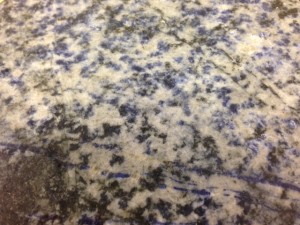A preview of our Stonexpo Presentation,
CSI (Critical Stone Investigation)
How Geology and Installation Affect Stone Restoration
Course # TU20, Tuesday, January 28, 2014
You’re at your local stone supplier and you know that you want to install granite countertops because you like the look of natural stone and you’ve heard granite is durable.
However, once the granite is installed, you notice etch marks are appearing all over the surface. Turns out the “granite” that you bought, is not a true granite. Many stones are sold commercially as granites, but are not true granites. They could be Sodalites, Diorites, Synites, Gabbros, etc.; all of these stones are natural stones, but they differ in their chemical compositions. Similarly, a number of “marbles” are not in fact true marbles.
Stones are identified by the minerals they contain. Granite is a siliceous stone, meaning that it contains silica, unlike calcareous stones such as marble and travertine that are composed of calcium carbonate, which reacts to acid.
Identifying stones correctly is important because we can determine the porosity, absorption and abrasion of the material.
Knowing which stones are in fact true granites and true marbles affects the fabrication, installation and restoration methods.
For example, Azul Bahia is a beautiful Sodalite that is typically sold as a granite, but it reacts to acids. The restoration of this material also varies from the way we would restore a true granite. The restoration of granites usually requires the use of diamond abrasives.


Sodalites and granites have different characteristics such as porosity and abrasion resistance. The level of abrasion resistance determines which tools are needed in order to grind, hone, or polish the stone surface, so it is important to know what stone you are dealing with. Because of its chemical composition and resistance to abrasion, Azul Bahia may be restored with honing and polishing compounds or other less abrasive methods.
Knowing the stone’s mineral hardness, acid sensitivity, and pore structure helps determine what type of restoration method professionals can use when restoring a stone floor or top. This includes the choice of tools, chemicals, abrasives, etc.
This post is just a preview of our Stonexpo course # TU20, “CSI (Critical Stone Investigation): How Geology and Installation Affect Stone Restoration.” Rawi Tabbah, David Bonasera and Chuck Muehlbauer will be presenting Tuesday, January 28, 2014 at the Mandalay Bay in Las Vegas.

3 Responses
2 Pingbacks
1 Trackback
[…] Granite and Marble: Common Misconceptions | Written in Stone […]
[…] do? My usual answer is: learn as much as you can about the stone itself. Learn to recognize marble from granite from limestone, etc. Then, learn some of the general characteristics of the various […]
I love your blog
I have read this article and enjoyed it